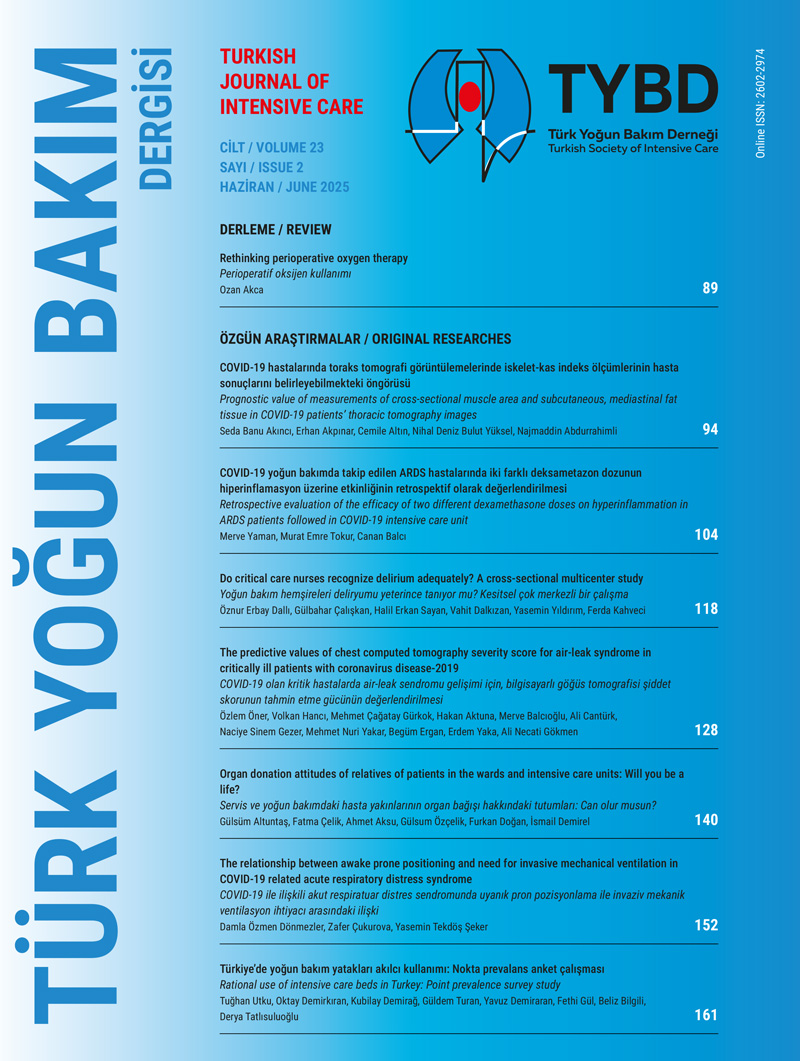Abstract
Introduction: To retrospectively compare the clinical and laboratory results of two different dexamethasone treatment protocols used in ARDS patients followed with COVID-19 in intensive care unit.
Materials and Methods: Patients who started dexamethasone treatment in Pandemic Intensive Care Units were divided into two groups. Group 1: 6 mg/day (n=41), Group 2: 0-5 days 20 mg/day and 6-10 days 10 mg/day (n=39). Clinical results and changes in laboratory values between groups from day 0 to day 10 were compared.
Results: Day 0 APACHE II scores were significantly higher in patients who received 20 mg (p: 0.039). When the parameter changes on days 0 and 10 after 10 days of dexamethasone treatment in the intensive care unit were analysed, it was determined that procalcitonin and D-Dimer values showed a statistically significant increase in the 20 mg group (p: 0.038 and p: 0.025, respectively). Finally, the effect of dexamethasone treatment on mortality was analysed and no difference was found between the groups.
Discussion and Conclusion: Mortality comparisons have been made in the literature regarding dexamethasone treatment in ARDS patients in COVID-19 intensive care units. We compared mortality and laboratory parameters. In conclusion; dexamethasone treatment improves clinical and laboratory parameters, but in terms of benefit / harm ratio and side effects; we think that 6 mg can be used safely in cases requiring oxygen therapy in viral respiratory tract infections and 20 mg in severe cases where hyperinflammation is at the forefront.
Keywords: anesthesiology and reanimation, intensive care, COVID, ARDS, dexamethasone
References
- Aydın NN, Aydın M, İba Yılmaz S. Evaluation of Hematological, Inflammatory and Coagulation Biomarkers as an Indicator of COVID-19 Severity. Flora the Journal of Infectious Diseases and Clinical Microbiology. 2023;28:188-97. https://doi.org/10.5578/flora.20239918
- The Recovery Collaborative Group; Horby P, Lim WS, et al. Dexamethasone in Hospitalized Patients with Covid-19. N Engl J Med. 2021;384:693-704. https://doi.org/10.1056/NEJMoa2021436
- Ak G, Yılmaz Ü. Covid-19 Pandemisinden Öğrendiklerimiz, Gelecek Öngörüleri ve Yarının Planlanması. İstanbul: Türkiye Solunum Araştırmaları Derneği; 2020.
- Villar J, Añón JM, Ferrando C, et al. Efficacy of dexamethasone treatment for patients with the acute respiratory distress syndrome caused by COVID-19: study protocol for a randomized controlled superiority trial. Trials. 2020;21:717. https://doi.org/10.1186/s13063-020-04643-1
- Zafer MM, El-Mahallawy HA, Ashour HM. Severe COVID-19 and Sepsis: Immune Pathogenesis and Laboratory Markers. Microorganisms. 2021;9:159. https://doi.org/10.3390/microorganisms9010159
- Ye Q, Wang B, Mao J. The pathogenesis and treatment of the 'Cytokine Storm' in COVID-19. J Infect. 2020;80:607-13. https://doi.org/10.1016/j.jinf.2020.03.037
- Henry BM, de Oliveira MHS, Benoit S, Plebani M, Lippi G. Hematologic, biochemical and immune biomarker abnormalities associated with severe illness and mortality in coronavirus disease 2019 (COVID-19): a meta-analysis. Clin Chem Lab Med. 2020;58:1021-8. https://doi.org/10.1515/cclm-2020-0369
- Stasi C, Fallani S, Voller F, Silvestri C. Treatment for COVID-19: An overview. Eur J Pharmacol. 2020;889:173644. https://doi.org/10.1016/j.ejphar.2020.173644
- Bouadma L, Mekontso-Dessap A, Burdet C, et al. High-Dose Dexamethasone and Oxygen Support Strategies in Intensive Care Unit Patients with Severe COVID-19 Acute Hypoxemic Respiratory Failure: The COVIDICUS Randomized Clinical Trial. JAMA Intern Med. 2022;182:906-16. https://doi.org/10.1001/jamainternmed.2022.2168
- Taboada M, Rodríguez N, Varela PM, et al. Effect of high versus low dose of dexamethasone on clinical worsening in patients hospitalised with moderate or severe COVID-19 pneumonia: an open-label, randomised clinical trial. Eur Respir J. 2022;60:2102518. https://doi.org/10.1183/13993003.02518-2021
- Villar J, Ferrando C, Martínez D, et al. Dexamethasone treatment for the acute respiratory distress syndrome: a multicentre, randomised controlled trial. Lancet Respir Med. 2020;8:267-76. https://doi.org/10.1016/S2213-2600(19)30417-5
- Abani O, Abbas A, Abbas F, et al.; RECOVERY Collaborative Group. Higher dose corticosteroids in patients admitted to hospital with COVID-19 who are hypoxic but not requiring ventilatory support (RECOVERY): a randomised, controlled, open-label, platform trial. Lancet. 2023;401:1499-507. https://doi.org/10.1016/S0140-6736(23)00510-X
- Abate BB, Kassie AM, Kassaw MW, Aragie TG, Masresha SA. Sex difference in coronavirus disease (COVID-19): a systematic review and meta-analysis. BMJ Open. 2020;10:e040129. https://doi.org/10.1136/bmjopen-2020-040129
- Karabıyık L. Yoğun bakımda skorlama sistemleri. Yoğun Bakım Dergisi. 2010;9(3):129-143.https://turkmedline.net/detay/yogun-bakimda-skorlama-sistemleri/ce125103272737ff/tr/66
- Cao L, Cherukuri K, Vu T, et al. APACHE II Score and Mortality Risk Prediction in a Californian Cohort of Critically Ill Patients With COVID-19. Chest 2021;160:A1032. https://doi.org/10.1016/j.chest.2021.07.957
- Azizmohammadi S, Azizmohammadi S, Dahmardeh S, et al. Analysis of 239 ordinary and severe cases of COVID-19: Clinical features and treatment. Eur J Transl Myol. 2021;31:9579. https://doi.org/10.4081/ejtm.2021.9579
- Moreno-Torres V, Sánchez-Chica E, Castejón R, et al. Red blood cell distribution width as a marker of hyperinflammation and mortality in COVID-19. Ann Palliat Med. 2022;11:2609-21. https://doi.org/10.21037/apm-22-119
- Zinellu A, Mangoni AA. Red blood cell distribution width, disease severity, and mortality in hospitalized patients with SARS-CoV-2 infection: A systematic review and meta-analysis. J Clin Med. 2021;10:286. https://doi.org/10.3390/jcm10020286
- Güçlü E, Kocayiğit H, Okan HD, et al. Effect of COVID-19 on platelet count and its indices. Rev Assoc Med Bras (1992). 2020;66:1122-7. https://doi.org/10.1590/1806-9282.66.8.1122
- Şenyurt O, Kaygusuz K, Avcı O, İsbir AC, Özdemir Kol İ, Gürsoy S. The relation of hemogram parameters with mortality in intensive care patients. Journal of CardioVascular Thoracic Anaesthesia and Intensive Care Society. 2018;24:165-71. https://doi.org/10.5222/GKDAD.2018.99267
- Ciaccio M, Agnello L. Biochemical biomarkers alterations in Coronavirus Disease 2019 (COVID-19). Diagnosis (Berl). 2020;7:365-72. https://doi.org/10.1515/dx-2020-0057
- Hong S, Wang H, Li S, Liu J, Qiao L. A systematic review and meta-analysis of glucocorticoids treatment in severe COVID-19: methylprednisolone versus dexamethasone. BMC Infect Dis. 2023;23:290. https://doi.org/10.1186/s12879-023-08280-2
- Keskinidou C, Vassiliou AG, Zacharis A, et al. Endothelial, Immunothrombotic, and Inflammatory Biomarkers in the Risk of Mortality in Critically Ill COVID-19 Patients: The Role of Dexamethasone. Diagnostics (Basel). 2021;11:1249. https://doi.org/10.3390/diagnostics11071249
- Gabarre P, Urbina T, Cunat S, et al. Impact of corticosteroids on the procoagulant profile of critically ill COVID-19 patients: a before-after study. Minerva Anestesiol. 2023;89:48-55. https://doi.org/10.23736/S0375-9393.22.16640-X
- Wang X, Tang G, Liu Y, et al. The role of IL-6 in coronavirus, especially in COVID-19. Front Pharmacol. 2022;13:1033674. https://doi.org/10.3389/fphar.2022.1033674
- Wagner C, Griesel M, Mikolajewska A, et al. Systemic corticosteroids for the treatment of COVID-19: Equity-related analyses and update on evidence. Cochrane Database Syst Rev. 2022;11:CD014963. https://doi.org/10.1002/14651858.cd014963.pub2
Copyright and license
Copyright © 2025 The Author(s). This is an open access article distributed under the Creative Commons Attribution License (CC BY), which permits unrestricted use, distribution, and reproduction in any medium or format, provided the original work is properly cited.






















